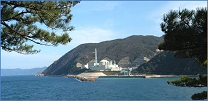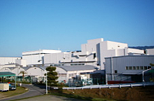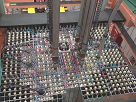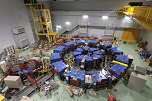Technical Tours [1]¶
- Visit to the Fukushima Dai-ichi Nuclear Power Plant (maximum 35 persons)
Attention
Tour registration for Fukushima Dai-ichi Nuclear Power Plant has been closed because of full capacity.
- Visit to the prototype Fast Breeder Reactor “Monju,” JAEA Tsuruga (maximum 30 persons)
Attention
Tour registration for “Monju” was closed on July 31, 2014.
- Visit to Kumatori area (maximum 20 persons), including the Nuclear Fuel Industries [2] (NFI) Ltd., Kumatori Works and the Kyoto University Research Reactor Institute (KURRI)
Attention
Tour registration for Kumatori was closed on July 31, 2014.
Attentions
| [1] | Participation is limited to citizens of the so-called “free trade countries” (also known as “white countries”). The 26 countries are: Argentina, Australia, Austria, Belgium, Canada, Czech Republic, Denmark, Finland, France, Germany, Greece, Hungary, Ireland, Italy, Republic of Korea, Luxemburg, Netherlands, New Zealand, Norway, Poland, Portugal, Spain, Sweden, Switzerland, United Kingdom, and the United States of America. More information about the background of limitations to participation can be found on the homepage of the Ministry of External Trade and Industry (METI) at: http://www.meti.go.jp/policy/anpo/securityexportcontrol3.html |
| [2] | Notice to participants wishing to visit the NFI facilities. NFI reserves the right to deny entrance to its facilities to visitors who are affiliated to industrial competitors. |
Time Schedule and Travel fee¶
- Fukushima Dai-ichi Nuclear Power Plant
- 10/2: Conf. Hotel (Afternoon) -> Tokyo (Stay)
- 10/3: Tokyo -> Fukushima -> Fukushima Dai-ichi NPP -> Tokyo (Evening; Dismiss)
- Monju in Tsuruga
- 10/3: Conf. Hotel (Morning) -> Monju -> Conf. Hotel (Evening)
- Kumatori area
- 10/3: Conf. Hotel (Morning) -> Kumatori -> Conf. Hotel (Evening)
1. Visit to Fukushima Dai-ichi Nuclear Power Plant¶
2. Visit to the prototype Fast Breeder Reactor “Monju,” JAEA Tsuruga¶
Monju¶
Monju is a 280MW electrical prototype, sodium cooled fast breeder reactor (FBR) using plutonium-uranium mixed oxide fuel. Monju achieved initial criticality in April 1994. In August 1995, Monju became the first Japanese FBR to generate power. It remains the only Japanese facility that can generate electricity using a fast breeder reactor. In December 1995, sodium coolant leaked from a temperature sensor in the secondary system piping. Since then, power generating operation has been suspended. Monju is still in the limelight as an international key facility of the fast breeder reactor R&Ds and is expected to, demonstrate its reliability as an operational power plant, and establish sodium handing technology.

3. Visit to Kumatori Area¶
Nuclear Fuel Industries, Ltd. (Kumatori Works)¶
Nuclear Fuel Industries, Ltd. (NFI) was established in 1972 and provides nuclear fuel and fuel-related services. It operates two fuel processing plants, a PWR fuel plant at Kumatori, and a BWR fuel plant at Tokai. Kumatori works has supplied over 9,000 PWR fuel assemblies for electric power companies. NFI will continue to supply reliable and high-quality products, and work towards a safer and more comfortable society.

Kyoto University Research Reactor Institute¶
The Kyoto University Research Reactor Institute (KURRI) was established in 1963 for the joint use program among Japanese universities to promote the research and education in the fields of nuclear energy and radiation application. Two nuclear reactors, the Kyoto University research Reactor (KUR) and the Kyoto University Critical Assembly (KUCA), and related research facilities have been being used since then, and nowadays greater expectations are being put on the research and education activities at our institute for the issues of energy and environment and for the innovative applications of radiation.
In addition, proton beams from the Fixed Field Alternating Gradient (FFAG) accelerator complex installed in the accelerator room is led to KUCA for the purpose of executing feasibility study on the accelerator-driven system (ADS).
The tour will include the KUCA facilities and the FFAG accelerator.

Kyoto University Critical Assembly (KUCA)¶
KUCA is a multi-core type critical assembly established in 1974 as a facility for the joint use study in reactor physics for researchers of all universities in Japan. It has three independent cores, namely, two solid moderated cores (A- and B- cores) and one light water-moderated core (C-core). A pulsed-neutron generator is also installed, which can be used normally in combination with the A-core.
In 2009, spallation neutrons generated by 100 MeV proton beams from the FFAG accelerator had been successfully injected into the A-core for the first time in the world.

Fixed Field Alternating Gradient (FFAG) accelerator¶
Proton beams from the FFAG accelerator complex installed in the accelerator room is led to the A-core at KUCA for the purpose of executing feasibility study on. The maximum energy of protons is 100 MeV and the maximum beam current is 1nA.

